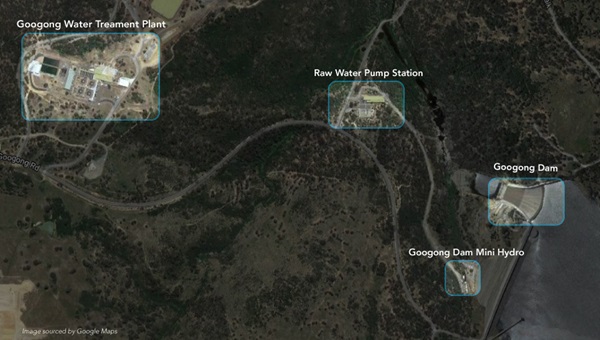Googong Dam Mini Hydro
What is the Googong Mini Hydro?
Googong Dam hosts a 600 kilowatt (kW) mini hydro system which utilises the environmental flows released from the dam. The mini hydro system comprises the following:
- Two Tamar Hydro Francis turbines designed for flows between 26 – 65 megalitres per day (ML/d) each (0.3 – 0.75 m3/s)
- Two 300 kW induction generators; one for each turbine
- Connection to Icon Water’s 11 kV network which distributes power to the Googong Water Treatment Plant (GWTP), Raw Water Pump Station (RWPS) and Googong Dam.
Where is the Googong Mini Hydro?
The Googong Dam Mini Hydro is located in a small building at the bottom of dam wall (off Googong Road, NSW). The hydro building is not visible from publicly accessible areas; however the Googong Dam lookout provides a publicly accessible viewpoint of the Googong Dam and intake tower.

When was it commissioned?
The Googong Dam Mini Hydro was originally commissioned in 2004. However the regulatory response to the Millennium Drought (2001-2009) reduced the total environmental flow to a minimum of 10 ML/d. This lower environmental flow combined with low dam levels meant the mini hydros were only rarely operated for maintenance and demonstration purposes.
Once the drought ended around 2012 and Googong Dam filled to capacity, Icon Water implemented a number of actions and minor upgrades to put the mini hydro system back in full service with operations recommencing at the end of 2015.
Why does Googong Dam have a mini hydro?
The Googong Dam Mini Hydro generates renewable electricity. Icon Water uses the ‘green’ electricity to power GWTP, RWPS and Googong Dam which reduces import electricity costs. Any surplus electricity generated is exported to the local distribution network and sold to a third-party. This results in a financial return on the capital investment and displaces electricity generation that would have otherwise been produced from fossil fuel generators.
The Googong Dam Mini Hydro also uses the regulated environmental flow to produce electricity. This flow is released from the reservoir to support downstream ecosystems and communities.
How does it work?
The Googong Mini Hydro is designed to operate whenever the environmental flow released from Googong Dam is within the turbine operating range. The generator starts to rotate when the bypass valve is closed and the turbine inlet valve is opened, diverting water through the turbine.
When in operation, guide vanes within the turbine are automatically adjusted to control the environmental flow released into the Queanbeyan River. The electricity generated by the mini hydros is fed to a nearby substation where a transformer converts the power from 415 volts to 11,000 volts for efficient transmission. An 11 kV overhead transmission line transmits the power approximately 500 metres into Icon Water's 11 kV network, which distributes the power to the GWTP, RWPS and Googong Dam.
How does the Googong Mini Hydro compare?
Hydro is the largest contributor to renewable generation in Australia, however this is quickly changing with installed hydro capacity remaining steady and significant growth in new wind and solar generation capacity.
The 600 kW (or 0.6 MW) Googong Mini Hydro is small in comparison to the 7,800 MW total hydro generation capacity available in the National Electricity Market (NEM)[1]. Hydro power generators registered in the NEM range anywhere from micro systems of 0.25 MW up to the very large 1,500 MW Tumut 3 hydro power station owned by Snowy Hydro Ltd which comprises 6 x 250 MW hydro generators.
Googong Mini Hydro capabilities:
- The Googong Dam Mini Hydro is capable of generating up to 4,200 Megawatt-Hours (MWh) per year, depending on storage levels at Googong, Corin and Bendora Dams and operational profile of GWTP. This represents up to 13% of Icon Water’s total electricity consumption in 2015-16 across its entire asset portfolio.
- Approximately 30% of the power generated by the mini hydro system is used by the GWTP, RWPS and Googong Dam with the remaining 70% exported to the grid.
- The power exported to the grid is the equivalent power supply of up to 350 homes.
- Up to 3,500 tonnes of greenhouse gas pollution is reduced as a result each year.
See the Googong Dam Mini Hydro factsheet for all the details.
[1]The National Electricity Market (NEM) is the Australian wholesale electricity market that covers the electrically connected states and territories of eastern and southern Australia.
